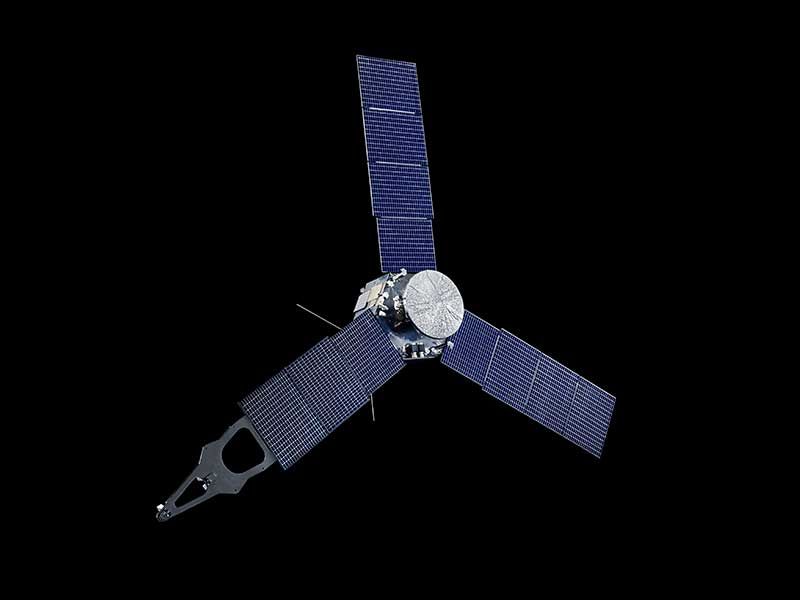Meet Scott Bolton, the Visionary Behind the NASA Mission to Jupiter
The Juno project will take on the mysteries of the gas giant that may in turn help us understand our own planet’s origins
:focal(2335x2721:2336x2722)/https://tf-cmsv2-smithsonianmag-media.s3.amazonaws.com/filer/76/ef/76ef6475-4c5e-4c96-8c9e-79d572f2c058/dec018_a05_ingenuity.jpg)
Jupiter guards secrets about the early solar system,” says Scott Bolton, standing in the cavernous and dimly lit mission control room at NASA’s Jet Propulsion Laboratory in Pasadena, California. “It grabbed most of the leftovers after the Sun formed. When we want to go back and try to understand how the planets were made—where the stuff that made us came from—Jupiter represents that first step.”
Bolton is the lead designer and principal investigator for NASA’s Juno spacecraft, currently looping around Jupiter after traveling nearly two billion miles. The mission’s goal is to understand the planet’s structure and the amount of water it contains. The results could yield rich new insights into how planets are born and how water appeared on Earth.
Bolton’s unorthodox proposal got critical feedback at first. Earlier missions to the outer solar system were nuclear-powered, but Bolton’s team designed Juno to run on solar energy. To protect the spacecraft from Jupiter’s radiation—“the throat of hell in our solar system,” in Bolton’s words—they created an armored vault with more than 400 pounds of titanium and crammed in the delicate circuitry Bolton calls Juno’s “central brain.” To limit the most intense exposure at the equator, Bolton’s team designed an elliptical orbit that races from the north pole to the south pole in just two hours and then ducks below the high-radiation belt. At its closest approach, Juno is a mere 3,000 miles above the planet’s cloud tops. For the rest of its 53-day loop, the spacecraft cruises millions of miles away from the planet.

Most radically, Bolton came up with a new way to solve the major puzzle left by the Galileo probe. That earlier mission to Jupiter had dropped a localized probe—which meant it may have sampled a particularly dry spot and missed more abundant water elsewhere. This time, instead of just measuring specific locations, Bolton thought of using microwave radiometers to estimate the water everywhere on Jupiter. The idea was so novel that Bolton’s team had to design a new instrument and plan a very different type of mission around this new kind of measurement. “I have always had a little element of me that was a rebel,” Bolton says wryly. “I rarely did something because people said it was the way we always did it.”
Bolton’s fascination with space emerged in the Apollo era. He was born in 1958, the same year as NASA. He and his pals in the Detroit suburbs watched “Star Trek” (“I wanted to be on the Enterprise,” he says), and he joined a club where he received new science-fiction books each month. In the late 1970s, when he was studying aerospace engineering at the University of Michigan, a speaker from JPL showed the class glorious images of Jupiter from the recently launched Voyager mission. “I was totally amazed,” recalls Bolton. During his senior year, he was hired by JPL, where he would work on the Gali-
leo mission before completing a PhD in astrophysics at the University of California, Berkeley.
Juno is only halfway through its planned lifetime (it’s scheduled to dive into the planet in 2021), but it has already upended much of the accepted wisdom. “I’m in total wonder that we could have been so wrong,” Bolton says. Scientists expected the planet’s fast rotation and whirling winds to mix all its gases into a uniform blend. Instead, they found that its colored bands and long-lasting storms, such as the Great Red Spot, have roots of ammonia and water that extend hundreds of miles deep. At the north and south poles, scientists were amazed to find cyclones packed like cinnamon buns—six at the north pole, nine at the south—all spinning the same direction.
They also found that Jupiter’s magnetic field is about twice as strong as scientists expected. And unlike Earth’s magnetic field—which arises from our planet’s core—Jupiter’s is surprisingly uneven between its poles. Bolton and others guess that just below the atmosphere, hydrogen is behaving like a metal, sparking part of Jupiter’s magnetism. Clues like these will lead to a better understanding of how planets form.
Bolton, who is also an associate vice president of the nonprofit Southwest Research Institute, oversees the Juno scientists who gather data as well as the engineers who control the spacecraft. “He has been an outstanding leader, and it’s not an easy job,” says David Stevenson, a senior Caltech theorist who has witnessed decades of solar system exploration. “He has this wonderful combination of leadership and scientific knowledge that motivates the mission.”
Bolton has also involved the public in groundbreaking ways. Juno’s website publishes raw images for citizen scientists to crop, color-correct and collage. Bolton’s friends in the music industry—ranging from the industrial musician Trent Reznor of Nine Inch Nails to the Greek composer Vangelis—have also boosted Juno’s popular appeal, creating Juno-related songs and film scores.
It’s a Renaissance approach Bolton finds deeply rewarding. After all, he points out, Galileo was an accomplished lute player before he observed Jupiter’s major moons. Three of those satellites have 1:2:4 harmonics: Every time Ganymede orbits Jupiter, Europa orbits twice and Io four times. Juno’s camera captured this celestial resonance for the first time and presented it to the public in a time-lapse video that’s been viewed more than two million times. “The innovation comes from the combination of analytic and creative thought,” Bolton says. “You couldn’t do Juno unless you had both halves of that.”
